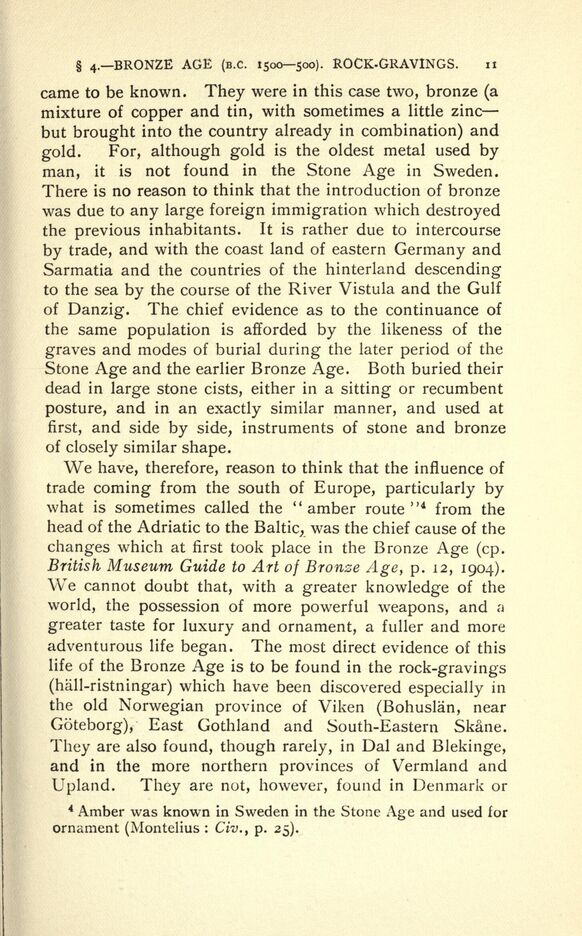
Full resolution (JPEG) - On this page / på denna sida - I. Introductory Lecture.—The Country and its Inhabitants in the Heathen Period up to 1000 A.D. - § 4. The Bronze Age

<< prev. page << föreg. sida << >> nästa sida >> next page >>
Below is the raw OCR text
from the above scanned image.
Do you see an error? Proofread the page now!
Här nedan syns maskintolkade texten från faksimilbilden ovan.
Ser du något fel? Korrekturläs sidan nu!
This page has never been proofread. / Denna sida har aldrig korrekturlästs.
4- BRONZE AGE (B.C. 1500500). ROCK-GRAVINGS. 11
came to be known. They were in this case two, bronze (a
mixture of copper and tin, with sometimes a little zinc
but brought into the country already in combination) and
gold. For, although gold is the oldest metal used by
man, it is not found in the Stone Age in Sweden.
There is no reason to think that the introduction of bronze
was due to any large foreign immigration which destroyed
the previous inhabitants. It is rather due to intercourse
by trade, and with the coast land of eastern Germany and
Sarmatia and the countries of the hinterland descending
to the sea by the course of the River Vistula and the Gulf
of Danzig. The chief evidence as to the continuance of
the same population is afforded by the likeness of the
graves and modes of burial during the later period of the
Stone Age and the earlier Bronze Age. Both buried their
dead in large stone cists, either in a sitting or recumbent
posture, and in an exactly similar manner, and used at
first, and side by side, instruments of stone and bronze
of closely similar shape.
We have, therefore, reason to think that the influence of
trade coming from the south of Europe, particularly by
what is sometimes called the "amber route"
4
from the
head of the Adriatic to the Baltic, was the chief cause of the
changes which at first took place in the Bronze Age (cp.
British Museum Guide to Art of Bronze Age, p. 12, 1904).
We cannot doubt that, with a greater knowledge of the
world, the possession of more powerful weapons, and a
greater taste for luxury and ornament, a fuller and more
adventurous life began. The most direct evidence of this
life of the Bronze Age is to be found in the rock-gravings
(hall-ristningar) which have been discovered especially in
the old Norwegian province of Viken (Bohuslan, near
Goteborg), East Gothland and South-Eastern Skane.
They are also found, though rarely, in Dal and Blekinge,
and in the more northern provinces of Vermland and
Upland. They are not, however, found in Denmark or
4
Amber was known in Sweden in the Stone Age and used for
ornament (Montelius :
Civ., p. 25).
<< prev. page << föreg. sida << >> nästa sida >> next page >>